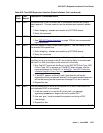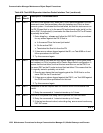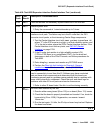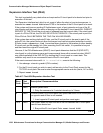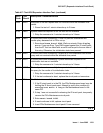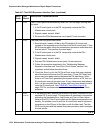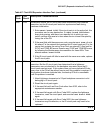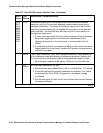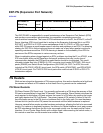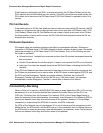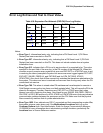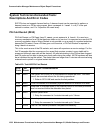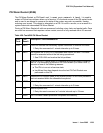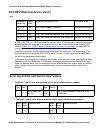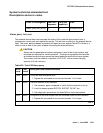
EXP-PN (Expansion Port Network)
Issue 1 June 2005 1235
EXP-PN (Expansion Port Network)
S8700 MC
The EXP-PN MO is responsible for overall maintenance of an Expansion Port Network (EPN)
and monitors cross-cabinet administration for compatible companding across the
circuit-switched connection. The focus of EPN maintenance is on the EI, the ATM’s EI, or the IP
Server Interface (IPSI) circuit pack that is acting as the Expansion Archangel link in an EPN.
EXP-INTF or ATM-EI or IP-SVR covers maintenance of the EI, ATM EI, or IPSI circuit pack,
while EXP-PN covers a much broader area of activities and problems on an EPN. The alarming
strategy for EXP-PN is fairly simple and does not make use of any failure analysis routine for
spawning maintenance actions. EXP-PN alarming is based on the availability of an EPN for
service and the EPN’s response to various recovery actions.
When investigating alarms logged against an EPN, problems involving the EI, an ATM EI, or an
IPSI circuit pack acting as the Expansion Archangel; problems that may involve loss of
communication between the EPN and the media server should be investigated. This could
ultimately include fiber links (FIBER-LK), DS1 converter circuit packs (DS1C-BD), SNI circuit
packs (SNI-BD) and Switch Node Configurations (SN-CONF) for CSS. For ATM, this could
include the PN ATM EI (ATM-EI) circuit pack, the ATM switch (ATM-NTWK), and EPN ATM EI
(ATM-EI) circuit pack. For TN2312 IPSI circuit packs this could include IP-SVR or IPSV-CTL
maintenance objects.
PN Restarts
While not an exhaustive discussion of PN recovery actions, this section describes at a high level
the causes and effects of PN restarts so that these Error Log events can be understood.
PN Warm Restarts
PN Warm Restart (PN Reset Level 1) is generally performed on a PN when the recovery of that
PN can be accomplished in less than 30 seconds. When possible, Warm Restart minimizes the
work required to reinitialize a PN and reduces the impact of a PN failure by avoiding the longer
and highly-destructive PN Cold Restart. The primary cause of PN restarts is failure of the link
from the media server to the PN due to a hardware fault in the link’s path. For most hardware
failures this link (and thus the PN) cannot be recovered until the failed hardware is replaced.
However, several failure modes provide hardware redundancy, allowing the link to be recovered
quickly. For instance in duplicated systems, the failure of a Packet Interface circuit pack causes
an IPSI interchange that allows the link to be recovered quickly over the newly-active Packet
Interface. Or on a Center Stage Switch with multiple fibers interconnecting the switch nodes, a
link carried on one fiber can be rerouted over another fiber.
MO Name in
Alarm Log
Alarm
Level
Initial SAT Command to Run
1
1. Investigate errors against EXP-PN and EXP-INTF.
Full Name of MO
EXP-PN MAJ display errors
1
Expansion Port Network



